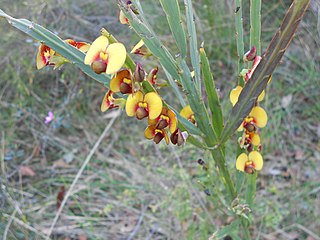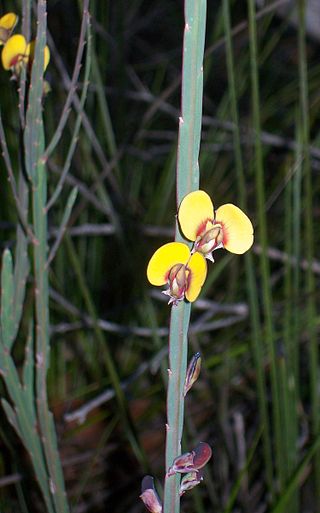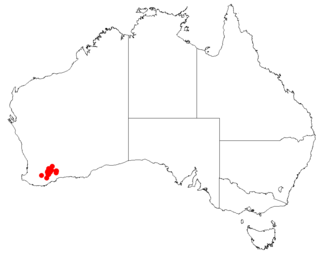
Bossiaea walkeri, commonly known as cactus bossiaea, cactus pea, or Walker's stick bush is a species of flowering plant in the pea family (Fabaceae) and is endemic to southern mainland Australia. It is a rigid, much-branched shrub with flattened, winged cladodes and red, pea-like flowers between July and November in the species' native range.

Bossiaea buxifolia, commonly known as matted bossiaea, is a species of flowering plant in the family Fabaceae and is endemic to south-eastern Australia. It is a prostrate to weakly erect shrub with elliptic to egg-shaped or almost round leaves and yellow, red and purplish flowers.

Bossiaea ensata, commonly known as sword bossiaea, is a species of flowering plant in the family Fabaceae and is endemic to south-eastern continental Australia. It is an erect or low-lying, glabrous shrub with flattened branches, flattened, winged cladodes, leaves mostly reduced to small scales, and orange-yellow and red flowers.

Bossiaea scolopendria, commonly known as plank plant, is a species of flowering plant in the family Fabaceae and is endemic to New South Wales. It is an erect, sparsely-branched shrub with flattened branches, ending in winged cladodes, the leaves mostly reduced to small scales except on the youngest branches, and yellow and red flowers.
Bossiaea vombata, commonly known as wombat bossiaea, is a species of flowering plant in the family Fabaceae and is endemic to the Wombat State Forest in Victoria, Australia. It is an erect shrub with flattened cladodes and yellow, pea-like flowers.
Bossiaea bracteosa, commonly known as mountain leafless bossiaea, is a species of flowering plant in the family Fabaceae and is endemic to north-eastern Victoria, Australia. It is a dense shrub that often forms root suckers and has winged branches, winged and lobed cladodes, leaves reduced to small scales, and deep yellow flowers, often with red blotches.

Bossiaea stephensonii is a species of flowering plant in the family Fabaceae and is endemic to near-coastal areas of New South Wales. It is a small, weakly erect, multi-stemmed shrub with sharply-pointed, mostly elliptic to egg-shaped leaves, and bright yellow and red flowers.

Bossiaea halophila is a species of flowering plant in the family Fabaceae and is endemic to Western Australia. It is a dense, erect, many-branched shrub with narrow-winged cladodes, leaves reduced to small scales, and yellow-orange and deep red flowers.

Bossiaea bombayensis, commonly known as bombay bossiaea, is a species of flowering plant in the family Fabaceae and is endemic to a small area of New South Wales. It is an erect shrub with flattened cladodes, small, scale-like leaves, and pea-like yellow to red flowers.
Bossiaea celata is a species of flowering plant in the family Fabaceae and is endemic to Western Australia. It is a compact, many-branched shrub with flattened cladodes, leaves reduced to scales, and yellow to pinkish-red pea-like flowers.
Bossiaea flexuosa is a species of flowering plant in the family Fabaceae and is endemic to Western Australia. It is a compact shrub with slightly flattened, zigzag branches, notched, more or less leafless cladodes, and golden yellow and red or pinkish flowers.

Pultenaea fragrans is a species of flowering plant in the family Fabaceae and is endemic to a small area of New South Wales. It is an erect shrub with flattened cladodes, small, scale-like leaves, and pea-like, yellow and red flowers.
Bossiaea milesiae is a species of flowering plant in the family Fabaceae and is endemic to a restricted area of New South Wales. It is an erect shrub with flattened, winged cladodes, small, scale-like leaves, and pea-like yellow to apricot-coloured and red flowers.
Bossiaea oligosperma, commonly known as few-seeded bossiaea, is a species of flowering plant in the family Fabaceae and is endemic to eastern New South Wales. It is an erect shrub with broadly egg-shaped to more or less round leaves with a small point on the tip, and yellow and red flowers.

Bossiaea oxyclada is a species of flowering plant in the family Fabaceae and is endemic to the south of Western Australia. It is an erect, rigid shrub with flattened branches, cladodes ending with a sharp point, leaves mostly reduced to small scales, and golden yellow and deep red flowers.
Bossiaea peninsularis is a species of flowering plant in the family Fabaceae and is endemic to the Eyre Peninsula in South Australia. It is an erect rhizome-forming, more or less leafless shrub with leaves reduced to small scales, and yellow, red and purplish flowers.
Bossiaea praetermissa is a species of flowering plant in the family Fabaceae and is endemic to near-coastal areas in the far south-west of Western Australia. It is a shrub with many flattened, winged cladodes and deep yellow and reddish or maroon flowers.

Bossiaea riparia, commonly known as river leafless bossiaea, is a species of flowering plant in the family Fabaceae and is endemic to south-eastern Australia. It is an erect or low-lying shrub with flattened branches, linear young cladodes, leaves mostly reduced to small scales, and yellow and red flowers.
Bossiaea saxosa is a species of flowering plant in the family Fabaceae and is endemic to a restricted area near Norseman, Western Australia. It is an erect, intricately branched shrub with many slightly flattened, sharply-pointed cladodes and deep yellow, red and lemon-yellow, pea-like flowers.
Bossiaea zarae, commonly known as Princess May winged pea, is a species of flowering plant in the pea family Fabaceae and is endemic to the northern Kimberley region of Western Australia. It is an erect shrub with winged stems, winged cladodes, scale-like leaves and yellow, and reddish-brown flowers.










